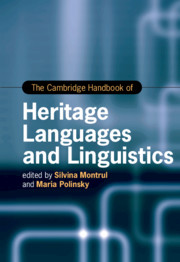Book contents
- The Cambridge Handbook of Heritage Languages and Linguistics
- Cambridge Handbooks In Language And Linguistics
- The Cambridge Handbook of Heritage Languages and Linguistics
- Copyright page
- Dedication
- Contents
- Figures and Tables
- Contributors
- Acknowledgments
- Introduction
- Part I Heritage Languages around the World
- 1 Slavic Heritage Languages around the Globe
- 2 Heritage Languages in Europe
- 3 Heritage Languages in Southeastern Europe
- 4 Heritage Languages in China
- 5 Heritage Languages in Japan and Korea
- 6 Heritage Languages in Israel
- 7 Heritage Languages in Aotearoa New Zealand and Australia
- 8 Heritage Languages in Canada
- 9 Asian Heritage Languages in the United States
- 10 The Vitality of Spanish as a Heritage Language in the United States
- 11 Germanic Heritage Varieties in the Americas
- 12 Arabic in North America
- 13 Heritage Languages in South America
- 14 Language Attrition and Heritage Language Reversal in Returnees
- Part II Research Approaches to Heritage Languages
- Part III Grammatical Aspects of Heritage Languages
- Part IV Heritage Language Education
- Index
- References
12 - Arabic in North America
from Part I - Heritage Languages around the World
Published online by Cambridge University Press: 04 November 2021
- The Cambridge Handbook of Heritage Languages and Linguistics
- Cambridge Handbooks In Language And Linguistics
- The Cambridge Handbook of Heritage Languages and Linguistics
- Copyright page
- Dedication
- Contents
- Figures and Tables
- Contributors
- Acknowledgments
- Introduction
- Part I Heritage Languages around the World
- 1 Slavic Heritage Languages around the Globe
- 2 Heritage Languages in Europe
- 3 Heritage Languages in Southeastern Europe
- 4 Heritage Languages in China
- 5 Heritage Languages in Japan and Korea
- 6 Heritage Languages in Israel
- 7 Heritage Languages in Aotearoa New Zealand and Australia
- 8 Heritage Languages in Canada
- 9 Asian Heritage Languages in the United States
- 10 The Vitality of Spanish as a Heritage Language in the United States
- 11 Germanic Heritage Varieties in the Americas
- 12 Arabic in North America
- 13 Heritage Languages in South America
- 14 Language Attrition and Heritage Language Reversal in Returnees
- Part II Research Approaches to Heritage Languages
- Part III Grammatical Aspects of Heritage Languages
- Part IV Heritage Language Education
- Index
- References
Summary
This chapter offers a-state-of-the-art review of the status and use of the Arabic language in North America. The chapter consists of six sections. The first section is an introduction to the Arabic language, its diglossic situation, and the geographic distribution of its speakers. The second section presents a brief history of Arab-speaking immigrants in North America as well as their demographic and sociolinguistic background. The third section focuses on the acquisition, development, and attrition/loss of colloquial Arabic by child and adult heritage speakers of Arabic. The fourth section explores the acquisition of Standard Arabic by heritage Arabic speakers in college-level Arabic-language classrooms. This section also considers some of the main differences between heritage speakers and second language learners of Arabic. The fifth section examines factors influencing Arabic language maintenance and loss among heritage speakers, including sociolinguistic, socio-contextual, and socio-affective factors (e.g., language input, language use, language attitudes, identity sentiments, family support, and the sociopolitical situation of Arab immigrants). The sixth and final section discusses the future of Arabic in the United States based on current trends and proposes directions for future research.
- Type
- Chapter
- Information
- The Cambridge Handbook of Heritage Languages and Linguistics , pp. 277 - 304Publisher: Cambridge University PressPrint publication year: 2021



